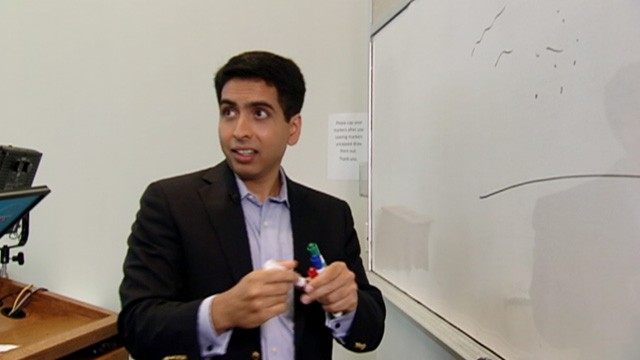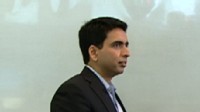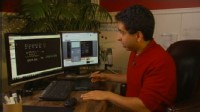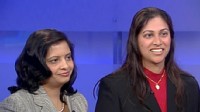Admit it, no matter how old you are, you can still remember what the bell sounded like at your school.
You can still remember pushing your way through the hallways to your next class, the sound of the chalk squeaking against the chalkboard or the minute hand ticking on the clock in your math class that you swore ran slower than every other clock in the building.
But that was then. Khan Academy is now.
Online learning on steroids, Khan Academy is a one-world schoolhouse that teaches thousands of free lessons on everything from algebra to medieval history to the fiscal cliff through YouTube. It is skyrocketing in popularity, sparking controversy and fundamentally challenging the very notion of education in the 21st century.
ABC News
Founder Sal Khan, seen here, launched Khan... View Full Size
Khan Academy: Why Is The Sky Blue? Watch Video
Winning the Lotto: What Are the Chances? Watch Video
Learn to Speak Hindi Online Watch Video
"What we're tackling right now is the learning side," said founder Sal Khan. "How can we democratize the knowledge so that anyone can get to the level they want to."
Khan founded the non-profit Khan Academy kind of by accident. Now 7 million students from around the world are "attending" the Khan Academy online every month and he said that number is growing by 400 percent per year.
His lessons have been viewed more than 200 million times, with more than half a billion exercises completed through the company's software, all in six years.
"I'm not an education radical," Khan said. "What I'm doing and we're doing is bringing back very old ideas that have been proven but somehow got lost in the haze."
Khan is an unlikely education reformer. He is a former hedge fund analyst -- MIT undergrad, Harvard MBA -- who just stumbled upon his revolution when he tried to help a young cousin with her algebra homework back in 2004.
"I started tutoring her remotely," he said. "I was in Boston, she was in New Orleans, and after that I started tutoring other family members and eventually started putting stuff on YouTube."
In a few weeks, Khan said he noticed that the lessons he was making for his relatives was going viral, racking up thousands of views, and he started receiving more and more requests from strangers for help.
Visually, Khan's YouTube videos are not the kind of videos you would expect to go viral. They are more of a virtual blackboard. But they work and education reformers all over the world have noticed, including some heavy hitters like Bill Gates.
Gates did more than look at the Khan Academy videos, he helped bankroll the project.
"[Gates] is incredibly sharp and really cares about these problems," Khan said.
So in 2009, Khan finally quit his job and partnered with the Gates Foundation and Google to form the Khan Academy.
Here's how it works: Students watch the videos and then work on a problem set based on the lesson posted on the company's website. If they pass, they move on to the next lesson. If it looks like they don't understand the concept, the website takes them back through what they missed.
The goal is not to replace the traditional classroom. The goal is to liberate it.
"The idea of students being grouped in age-based cohorts, going in a set pace, the sort of school we all grew up in, taking notes, passive in the lecture hall, this was not the way students were educated for most of history," Khan said. "It's not the way humans naturally learn if we look at the research."
Instead, Khan and his allies see classrooms thrumming with creative activity, spurred by the fact that kids will have already engaged the subject matter through the online lessons.
His ideal classroom, Khan said, is not a bunch of chairs all positioned to look at a teacher standing in front of the class, but a "much more collaborative space."
"It's not one pace fits all anymore," he said. "The teacher will be doing focused interventions with them. They will be monitoring them, inspiring them. They won't be lecturing them."
About 25 to 30 schools, most of them based around Silicon Valley, have started implementing the Khan Academy as a pilot program, exploring how it might change teaching and learning.
Khan and his academy have plenty of critics. Some argue that his approach is likely to work only for students who are already motivated self-starters -- while leaving many other kids behind. And other critics contend that online learning dilutes an essential dimension of learning: The human connection between good teachers and students.
Khan said the best answer to his critics comes from the very kids who use his lessons and exercises.
"The single biggest thing that happened, not obvious to us at first, the teachers and the principal told us is that the students started to take ownership of their learning," he said. "They started not to say, 'Hey, I'm passive, tell me what to do next.' They started to say, 'These are my goals. I'm going to seek out information, teacher, you are my coach, you're my mentor, help me do it.'"
Times are changing, but one thing is constant: The preciousness of our children, the beauty of their young minds, the hopes we have for them.
They are already online. Maybe, at least in some ways, that is where their classrooms can be too.





Nenhum comentário:
Postar um comentário